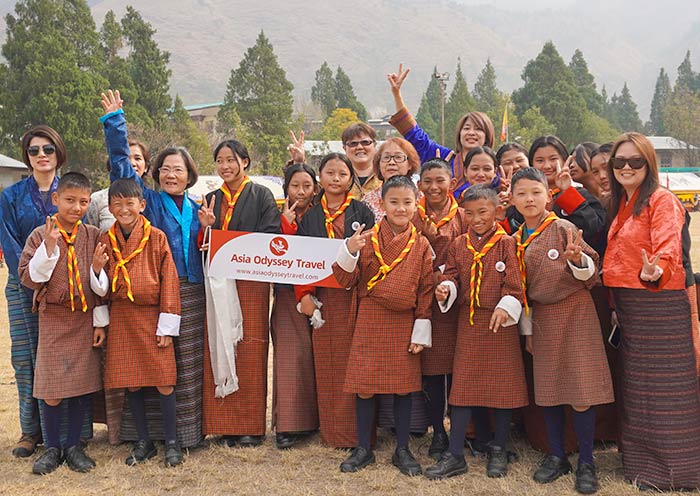Punakha Dzong Location: Sacred and Strategic
Dzong, including Punakha Dzong, is essentially a religious center, an administrative hub, and a social gathering place, and practically the heart of Bhutan's spiritual and daily life activities. As a iconic Bhutan's attraction it is one the 10 Best Places to Visit in Bhutan and one of the most famous Dzongs to Visit in Bhutan.
Punakha Dzong, nestled at the meeting point of the Pho Chhu and Mo Chhu rivers in Bhutan, stands proudly at an Altitude of 1,200 meters (approximately 3,937 feet). The climate here is a dance between subtropical warmth and cool mountain air, with temperatures that range from a crisp 12°C (54°F) in Winter to a balmy 32°C (90°F), which is warmer than Thimphu and Paro. That's why Punakha Dzong serves as the winter residence of the Je Khenpo, the Chief Abbot of Bhutan.


Punakha Dzong History: Inspired by Divine Vision
Once upon a time, in the year of 1637, a man of great vision, Ngawang Namgyal, the 1st Zhabdrung Rinpoche, laid the foundation of a majestic structure, the Punakha Dzong. This grand edifice, completed in a span of just one year, was not the work of mere mortals alone. It was said to be inspired by a dream, a vision of a divine palace for Guru Rinpoche.
For many years, Punakha Dzong was the heart of Bhutan, the seat of its government until 1955 when the capital was moved to Thimphu. Punakha Dzong safeguarded the sacred relics of the southern Drukpa Lineage of the Kagyu school of Tibetan Buddhism, including the Rangjung Kharsapani and the sacred remains of Ngawang Namgyal and the tertön Pema Lingpa.
As the seasons changed, so did the Punakha Dzong's role. In the cold Winter months, Punakha Dzong served as the warm abode for the Je Khenpo, the Chief Abbot of Bhutan. Today, it continues to be a beacon of faith and administration, its monastic sections adorned with beauty and reverence.
Punakha Dzong Architecture: Full of Wonders, without a Nail
Punakha Dzong, a Bhutanese architectural marvel, exemplifies the distinctive Dzong style with its massive, inward-sloping walls and a broad red ochre band. Constructed without nails, using interlocking stones and wooden beams, Punakha Dzong stands as a testament to the ingenuity of traditional Bhutanese architecture. This second oldest Dzong in Bhutan, symbolizing the country's rich cultural heritage, contributes to its uniqueness and grandeur.
Unique 3 Docheys Design: Adding Sanctity to Punakha Dzong
In a typical Dzong design, there are two Docheys (courtyards), while Punakha Dzong has three Docheys. Punakha Dzong stands out with its unique three-courtyard design.
- The first courtyard is dedicated to administrative functions, featuring a large white Victory Chorten and a Bodhi tree.
- The second, the smallest, serves as the entrance to the central tower.
- The third docheys of Punakha Dzong, the most significant, houses the main temple and the temple holding national treasures.
This design allows for a clear separation of administrative and religious functions, with an added layer of sanctity in the third courtyard. This distinct layout enhances the grandeur of Punakha Dzong, making it a unique embodiment of Buddhist values.
Bridge of Punakha Dzong: Bazam the Second
The Bazam Bridge of Punakha, Bhutan, rebuilt in 2008, is the only access to Punakha Dzong. The original bridge built in the 17th century was washed away during a flood in 1958. So the Bazam Bridge you see now is Bazam, the Second. It spans the Mo Chhu river, connecting Punakha Dzong to Shengana, Samdingkha, and Wangkha villages. Its traditional Bhutanese architecture and colorful prayer flags make it a unique and vital link. It offers stunning views of the river and valley.


Punakha Dzong Scenic Beauty: Colors of Happiness
The area surrounding Punakha Dzong is a breathtaking tapestry of natural beauty. The Mo Chhu river flows serenely, reflecting the azure sky above and the lush greenery on its banks. Majestic mountains stand guard for Punakha Dzong in the distance, their peaks often shrouded in mist. The region is rich in flora, with unique flowers adding splashes of color to the landscape and a variety of trees providing a verdant canopy. The air is filled with the sweet scent of blossoms and the soothing sounds of nature.
Punakha Dzong itself is a jewel set in this stunning environment. Punakha Dzong traditional Bhutanese architecture, characterized by intricate woodwork and vibrant murals, is a sight to behold. The Punakha Dzong's grandeur is amplified by its location at the confluence of the Mo Chhu and Po Chhu rivers. The reflection of the Punakha Dzong in the clear river waters, framed by the mountains and the sky, creates a picture of ethereal beauty. Amidst the surrounding natural scenic beauty, Punakha Dzong stands as a testament to Bhutan's rich cultural heritage and architectural prowess.
If you are particularly fond of tranquil nature, consider taking a trekking route near Punakha Dzong: Cultural Trek Covering Punakha.
Punakha Dzong Events: Living History, Enchanting Culture in the Flesh
Punakha Dzong is more than a mere architectural marvel; it's the pulsating core of Bhutan, where echoes of the past resonate, spirituality lights the way, and culture comes alive with each billowing prayer flag. Punakha Dzong has been the stage for numerous significant events and will continue to host more in the future.
Historical Events at Punakha Dzong: Echoes of Bhutanese Tradition
- Founding and Monastic Establishment: In 1637, Zhabdrung Ngawang Namgyal built Punakha Dzong and set up the Central Monastic Body with 600 monks.
- First King's Coronation: Ugyen Wangchuck, Bhutan's first king, was crowned at Punakha Dzong in 1907.
- Royal Wedding: The royal wedding of King Jigme Khesar Namgyel Wangchuck and Queen Jetsun Pema took place in Punakha Dzong in October 2011.
- Sacred Rite of the Fifth King: Enshrouded in mystique, the fifth and reigning King, Jigme Khesar Namgyel Wangchuck, partook in a hallowed ceremony within the sacred walls of Punakha Dzong.

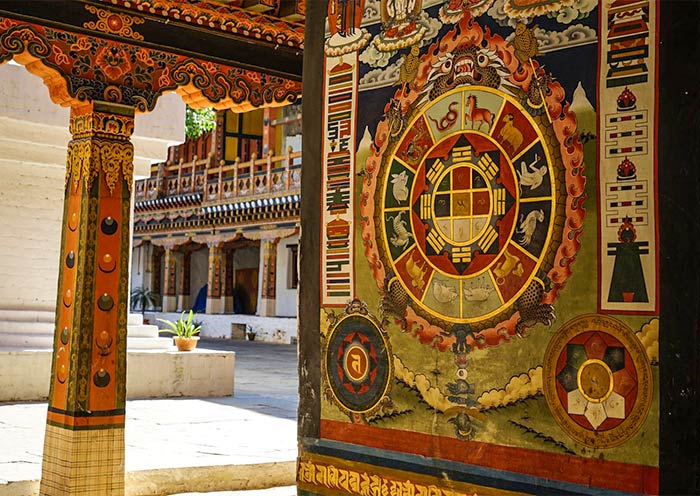
Be Part of Punakha Dzong's Unforgettable Events: From Coronations to Celebrations
Dromchoe Festival at Punakha Dzong: Dance in the Shadows
This five-day Festival explores tantric rituals and formidable protectors. It's dedicated to Mahakala, a deity symbolizing fury and wisdom, with a focus on spiritual cleansing and repelling malevolent forces.
- Masked Protectors: Monks enact complex masked dances, each symbolizing a particular deity or demon. These dances portray the conflict between good and evil, ending with the defeat of negativity. Anticipate vivid costumes, resonating drums, and spine-tingling chants.
- Veiled Rituals: While some Dromchoe rituals are public, others are cloaked in secrecy, adding a layer of intrigue. These restricted areas are typically for monks performing advanced tantric practices.
- Timing: Typically in February, during the Bhutanese lunar month of Chochor in Punakha Dzong.
Tshechu Festival at Punakha Dzong: Festival of Enlightenment
Contrasting Dromchoe's solemnity, Tshechu is a lively tribute to Guru Rinpoche, the originator of Bhutanese Buddhism. It's a festive event filled with radiant dances, music, and cultural performances.
- Revealing the Thangka: The climax of Tshechu is the unveiling of a grand thangka portraying Guru Rinpoche in all his splendor. This holy tapestry is gradually disclosed, eliciting awe and reverence among the spectators.
- Masked Dances with a Difference: Tshechu showcases masked dances that narrate stories from Guru Rinpoche's life and teachings. Unlike Dromchoe's intense battles, these dances highlight his kindness, wit, and victories over negativity.
- Cultural Extravaganza: Tshechu is a public Festival inviting everyone to join. Savor traditional Bhutanese cuisine, watch archery contests, and soak in the contagious joy of the celebration.
- Timing: Celebrated in February or March, based on the lunar calendar.

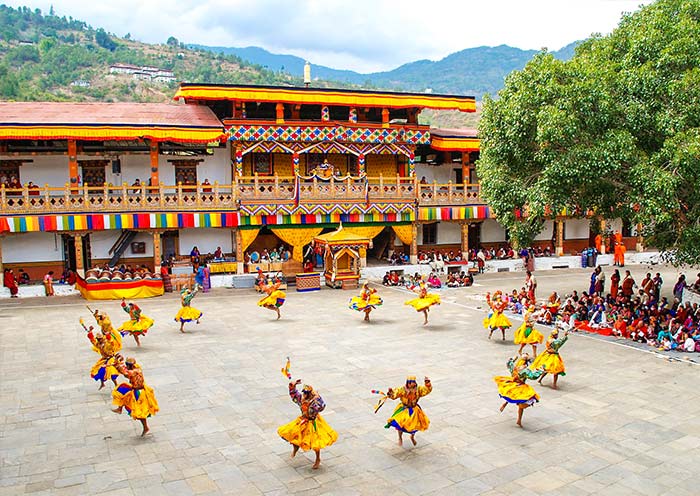
Dromchoe and Tshechu offer two contrasting windows into Bhutanese culture. Dromchoe is a glimpse into the esoteric world of tantric rituals and powerful protectors, while Tshechu is a joyous celebration of faith, community, and cultural heritage. Whether you seek spiritual introspection or vibrant festivities, both festivals have something unique to offer, making Punakha Dzong a truly captivating destination.
The Bhutanese festivals are scheduled based on the lunar calendar, with local customs and religious significance also influencing their timing. As these factors can cause dates to vary each year, it's recommended to check specific Festival Dates annually if planning to attend.
Punakha Dzong's Treasury: A Journey into the Realm of Mysterious Relics
As we mentioned, Punakha was Bhutan's capital for centuries. It is indeed a spiritual centre and a fortified castle in nature. Punakha Dzong is a sacred and safe place, and it was the centre of the Kingdom for a long time. There simply is no better place to keep the treasures of the Bhutan Kingdom than Punakha Dzong. Let's take a sneak peak of the hidden treasure at Punakha Dzong.
Sacred Relics at Punakha Dzong: Statue Buddha Shakyamuni & More
- Machen Chorten: This sacred stupa enshrines the remains of Zhabdrung Ngawang Namgyal, the unifier of Bhutan, and is considered one of the most important religious sites in the country.
- Jhado Namkha: This statue of the Buddha Shakyamuni is believed to be self-manifested and holds immense spiritual power.
- Guru Rinpoche's Relics: Various relics attributed to Guru Rinpoche, the founder of Bhutanese Buddhism, are housed within the Dzong, adding to its sanctity.
- Tantric Ritual Objects: Ritual implements used in tantric practices, such as vajras and bells, are carefully preserved and considered powerful tools for spiritual advancement.

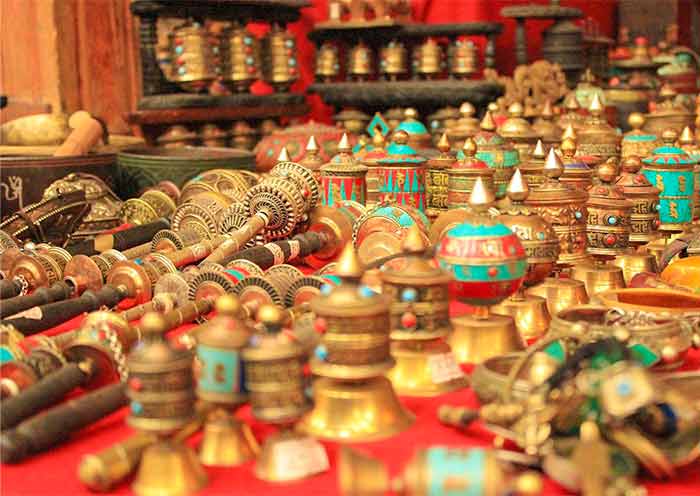
National Treasures at Punakha Dzong: Exquisite Artifacts & Royal Legacy
- Panchkula: This five-storied gilt stupa, adorned with intricate carvings, is a stunning example of Bhutanese craftsmanship and houses sacred relics.
- Buddha Shakyamuni Statues: Numerous statues of Buddha Shakyamuni, each unique in style and size, grace the Dzong's halls, reflecting the diversity of Buddhist traditions.
- Thangkas: Exquisitely painted thangkas depicting deities, mandalas, and Buddhist stories adorn the walls, offering a vibrant visual representation of Bhutanese faith.
- Royal Artifacts: Weapons, armor, and other objects belonging to Bhutanese royalty are preserved within the Dzong, providing a glimpse into the country's past.
- Ancient Manuscripts: A collection of ancient manuscripts, including religious texts and historical records, offer valuable insights into Bhutan's rich cultural heritage.
In addition to the treasures already mentioned, Punakha Dzong is believed to house numerous other undiscovered gems. Certain areas and relics might be off-limits due to their sacred significance or preservation requirements. Nonetheless, the mere experience of being in the Dzong's ambiance and hearing the tales echoed within its walls is truly unique.
If Bhutanese relics and treasures pique your interest, you might want to visit the National Museum in Paro or the Folk Heritage Museum in Thimphu. These museums host special exhibitions that display the rich cultural and religious heritage of Bhutan.
Best Time to Visit Punakha Dzong: Rhododendrons & Rafting
With grand rivers and flora surrounding Punakha Dzong, we recommend spring and autumn besides the exact dates of the events. Here's a detailed breakdown. Find out when is your Best Time to Visit Bhutan.
Best Time for Flowers at Punakha: Rhododendrons with Dazzling Colors
- March to May: Punakha transforms as spring breathes life into the Valley, adorning it with vivid hues. The hillsides are awash with the vibrant colors of blooming rhododendrons, while magnolias and cherry blossoms enhance the floral spectacle.
- September to October: It brings a second wave of blossoms. The valley is draped in the rustic allure of golden-red buckwheat fields. Late bloomers like rhododendrons and other wildflowers may also be spotted, adding to the autumnal panorama.
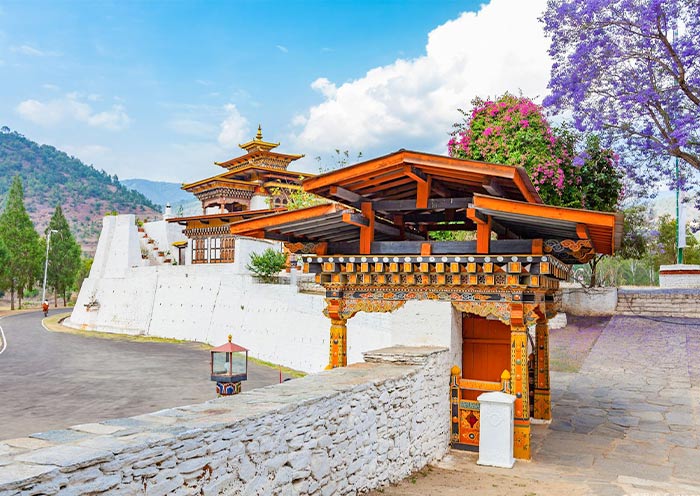

Best Time for River Rafting:
- From March to May: The thawing of Winter snow causes the Mo Chhu River to rise, forming thrilling rapids that are ideal for intermediate and advanced rafters. However, be ready for chillier water temperatures. River Rafting is also one of the Best Things to Do in Bhutan.
- Between June and August: the Mo Chhu is at its highest flow due to the monsoon season, providing the most intense rafting experience for experienced adventurers. But be aware, heavy rainfalls can occasionally result in temporary shutdowns.
| Season | Best for Flowers | Best for Rafting | Pros | Cons |
|---|---|---|---|---|
| March-May | Excellent | Good | Beautiful flowers, pleasant Weather in Punakha, good rafting conditions | Crowds, higher prices |
| September-October | Good | Fair | Unique fall foliage, less crowded | Cooler weather, lower water levels |
| June-August | Not recommended | Excellent | Highest water levels, thrilling rafting | Monsoon rains, potential closures |
Additional Tips on Visiting Punakha Dzong:
- Ensure to reserve your trip and lodging ahead of time, particularly during the high season from March to May.
- Also, it's crucial to stay updated with the most recent Weather in Punakha forecasts prior to your journey, as rainfall and elevated water levels can affect both the viewing of flowers and rafting activities.
Alternatively, you could opt for a Bhutan tour where all the wonderful experiences are pre-arranged for you, including cultural events, sightseeing, and river rafting. Here's How to Visit Bhutan in general.
How to Plan Your Bhutan Journey to Explore Punakha & Beyond
To Visit the very essence of Bhutan allow at least 3-6 days to cover the major cities and attractions including Paro, Thimphu, Punakha.
- 5 Days Iconic Bhutan Tour to Paro, Thimphu & Punakha - Highlights of Bhutan>>
- 6 Days Bhutan Essence Tour to Paro, Thimphu, Punakha & Phobjikha Valley >>
- 6 Days Bhutan Culture Tour to Paro, Thimphu, Punakha - Insider Culture Trip >>
Uncover Bhutan's rich culture and hidden gems. Explore Gangtey, Haa, Bumthang, and more in the Land of Happiness!
- 7 Days Bhutan Tour with Haa & Phobjikha Valley - Off the Beaten Path>>
- 8 Days Ideal Bhutan Tour: Slow-paced & In-depth Travel>>
- 10 Days Impressive Bhutan Wonders Tour: Exploring History, Spirituality & Hiking>>
Find serenity in the footsteps of royalty: Wander the paths treasured by the King of Bhutan, where untouched beauty whispers tales of peace.Hiking Tours>>
- 4 Days Best Bhutan Tour Package with Tiger's Nest Hike>>
- 8 Days Bhutan Tour with Stunning Light Hiking in Western Bhutan>>
- Bumthang Cultural Trek - 11 Days Bhutan Trekking Tour to Bumthang>>
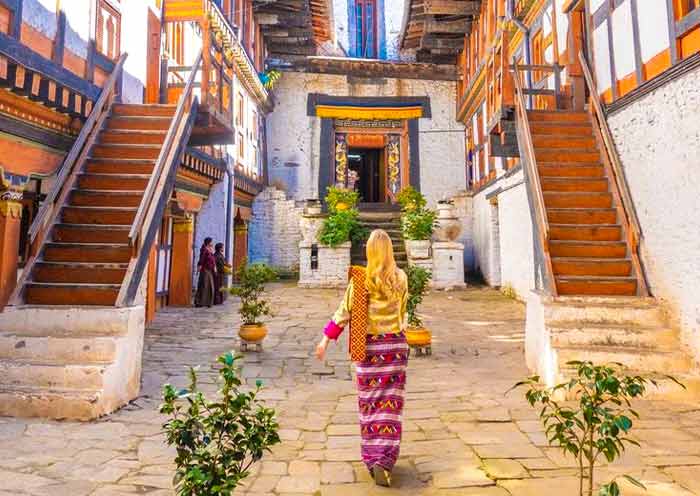

Want to truly capture the spirit of Bhutan? Plan your trip around a lively festival and join the celebrations! When you see the joy and magic flowing through the land, you'll understand why it's called the "Land of Happiness."
- 7 Days Paro Tshechu Festival Tour of Bhutan (March 21-25, 2024)>>
- 7 Days Thimphu Tshechu Festival of Bhutan Bhutan (Sep. 13-15, 2024)>>
- 7 Days Punakha Festival Tour Bhutan ( Drubchen & Tshechu Feb. 17-21, 2024)>>
For Traveler in Bhutan, luxury whispers a different tune. It's the embrace of inner peace, the serenade of tranquility, the hushed elegance of a spiritual retreat. It's a grand symphony of calmness, a state of mind untouched by the everyday mundane. This is the true Luxury Hotels you won't find elsewhere. So, let your journey begin here.
- Intimate Getaway, Spark Romance : 7 Days Como Uma Bhutan Luxury Tour>>
- Mixed Vibe, Premium All the Way: 7 Days Bhutan Luxury Tour - Le Meridien & COMO Uma>>
- Serene Valley, Share Universe with Wildlife Creatures 8 Days Luxury Tour with Gangtey>>
Bhutan is Also a Perfect Destination for Loving Couples. From "I do" to "Happiness Forever".
Check detailed guide on How to Visit Bhutan.
Travel with AOT, Your Journey to Happiness Starts Here
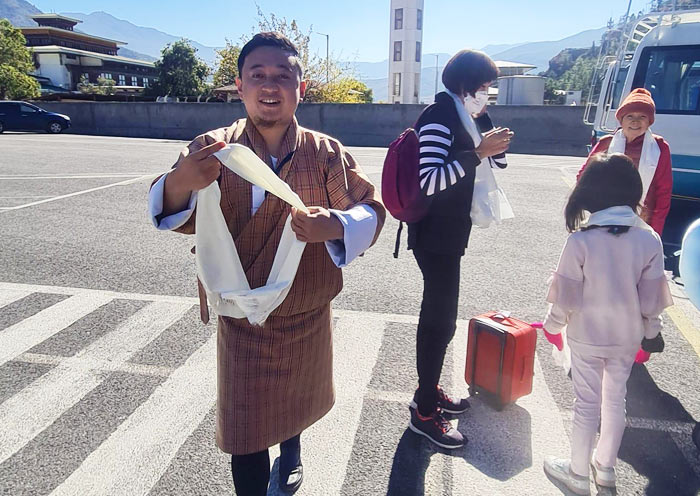

In Bhutan, where clouds dance with prayer flags and mountains pierce the sapphire sky, your soul finds its melody. Hike through emerald valleys kissed by cool mountain mist, where ancient dzongs whisper secrets of the past. Dance with masked deities beneath a tapestry of stars, their vibrant costumes echoing the hues of spring wildflowers. Here, happiness blooms like rhododendrons on sun-drenched slopes, leaving you forever changed, a symphony of memories forever playing in your heart.
Asia Odyssey Travel has been actively introducing Bhutan to the world, opening up an amazing journey for those who seek a unique trip to Bhutan. With AOT's experienced Bhutan Local Team and our professional travel consultant team, we offer comprehensive services as your outstanding travel agency. Moreover, we act as a reliable travel companion on your journey to inner peace and happiness. Plan your lifetime Bhutan journey with AOT. Contact us now, let's embrace happiness in Bhutan together!
If you have any questions about this article, please contact us by submitting the following form and we'll immediately get back to you.










